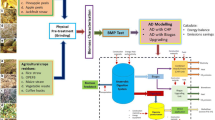Abstract
Energy has a strategic importance for all countries. To keep limited energy resources in proper use for a long time, the use of new energy and renewable energy resources should be expanded.
Significant amounts of organic residues are produced every year in agricultural areas and agro-industrial activities. Evaluating biomass resources and bringing them into the economy, they can be converted into useful energy in the area or region where they are formed.
Turkey is one of the most important olive oil producers in the world, located in the Mediterranean Region. Olive pulp or pomace, as it is commonly known, produced in olive oil production is generally evaluated by burning.
In this study, biogas production amounts were determined by adding olive pomace in different proportions to cattle manure. The experiments were carried out in laboratory-type biogas reactors. The retention time was chosen as 15 days, the fermentation temperature was 37 °C, and the dry matter content was 7%. The experiments were carried out in 4 reactors as only cattle manure, 10% olive pomace + 90% cattle manure mixture, 25% olive pomace + 75% cattle manure mixture, and 40% olive pomace + 60% cattle manure mixture.
According to the experiment results, the highest daily methane production was obtained in the mixture with 40% olive pomace added. In methane production per organic dry matter, the mixture to which 25% olive pomace was added produced the highest methane.




Similar content being viewed by others
Data availability
Data sharing not applicable to this article as no datasets were generated or analyzed during the current study.
References
IEA (2022) World Energy Outlook 2022. International Energy Agency. https://iea.blob.core.windows.net/assets/830fe099-5530-48f2-a7c1-11f35d510983/WorldEnergyOutlook2022.pdf. Accessed Mar 2023
FAOSTAT (2021) Food and Agriculture Organization of United Nations Database. Available online: https://www.fao.org/faostat/en/#data. Accessed Jan 2023
Khdair A, Abu-Rumman G (2020) Sustainable environmental management and valorization options for olive mill byproducts in the Middle East and North Africa (MENA) region. Processes 8:671. https://doi.org/10.3390/pr8060671
Moreno-Maroto JM, Uceda-Rodríguez M, Cobo-Ceacero CJ, De Hoces MC, MartínLara MÁ, Cotes-Palomino T, LópezGarcía AB, Martínez-García C (2019) Recycling of ‘alperujo’ (olive pomace) as a key component in the sintering of lightweight aggregates. J Clean Prod 239:118041. https://doi.org/10.1016/j.jclepro.2019.118041
Ribeiro TB, Oliveira AL, Costa C, Nunes J, António A, Vicente AA, Pintado M (2020) Total and sustainable valorisation of olive pomace using a fractionation approach. Appl Sci 10:6785. https://doi.org/10.3390/app10196785
Karantonis HC, Tsantila N, Stamatakis G, Samiotaki M, Panayotou G, Antonopoulou S, Demopoulos CA (2008) Bioactive polar lipids in olive oil, pomace and waste byproducts. J Food Biochem 32:443–459. https://doi.org/10.1111/j.1745-4514.2008.00160.x
Vlyssides AG, Loizides M, Karlis PK (2004) Integrated strategic approach for reusing olive oil extraction by-products. J Clean Prod 12:603–611. https://doi.org/10.1016/S0959-6526(03)00078-7
Roig A, Cayuela ML, Sanchez-Monedero MA (2006) An overview on olive mill wastes and their valorisation methods. Waste Manage 26:960–969. https://doi.org/10.1016/j.wasman.2005.07.024
Christoforou E, Fokaides PA (2016) A review of olive mill solid wastes to energy utilization techniques. Waste Manage 49:346–363. https://doi.org/10.1016/j.wasman.2016.01.012
Ducom G, Gautier M, Pietraccini M, Tagutchou J-P, Lebouil D, Gourdon R (2020) Comparative analyses ofthree olive mill solid residues from di_erent countries and processes for energy recovery by gasification. Renew Energy 145:180–189. https://doi.org/10.1016/j.renene.2019.05.116
Tekin AR, Dalgıç AC (2000) Biogas production from olive pomace. Resour Conserv Recycl 30(4):301–313. https://doi.org/10.1016/S0921-3449(00)00067-7
Rashed MB (2014) The effect of temperature on the biogas production from olive pomace. Univ Bull 3(16):135–148
Ulukardesler A, Ulusoy Y, Tumsavas Z (2016) Biogas production from olive waste and olive pomace in Marmara region. Fuels and Combustion in Engineering Journal 3:21–24. https://dergipark.org.tr/tr/download/article-file/303204
Valenti F, Zhong Y, Sun M, Porto SMC, Toscano A, Dale BE, Sibilla F, Liao W (2018) Anaerobic co-digestion of multiple agricultural residues to enhance biogas production in southern Italy. Waste Manage 78:151–157. https://doi.org/10.1016/j.wasman.2018.05.037
Riggio V, Comino E, Rosso M (2015) Energy production from anaerobic co-digestion processing of cow slurry, olive pomace and apple pulp. Renew Energy 83:1043–1049. https://doi.org/10.1016/j.renene.2015.05.056
Elalami D, Carrere H, Abdelouahdi K, Garcia-Bernet D, Peydecastaing J, Vaca-Medina G, Barakat A (2020) Mild microwaves, ultrasonic and alkaline pretreatments for improving methane production: impact on biochemical and structural properties of olive pomace. Biores Technol 299:12259. https://doi.org/10.1016/j.biortech.2019.122591
APHA (2023) Standard methods for the examination of water and wastewater. In: Lipps WC, Braun-Howland EB, Baxter TE, eds. American public health association, american water works association, water environment federation, 24th edn. APHA Press, Washington DC
Tufaner F (2020) Zeytin Posası (Pirina) Atıklarından Biyogaz Üretimi, V. Uluslararası Battalgazi Bilimsel Çalışmalar Kongresi, Kongre Kitabı, 18–20 Aralık 2020 Malatya, pp 511–519. https://www.researchgate.net/profile/Fatih-Tufaner/publication/347998946_Biogas_Production_From_Olive_Pomace_Prina_Wastes_Zeytin_Posasi_Pirina_Atiklarindan_Biyogaz_Uretimi/links/625e7301a279ec5dd701dd9e/Biogas-Production-From-Olive-Pomace-Prina-Wastes-Zeytin-Posasi-Pirina-Atiklarindan-Biyogaz-Ueretimi.pdf
Amirante R, Demastro G, Distaso E, Hassaan MA, Mormando A, Pantaleo AM, Clodoveo ML (2018) Effects of ultrasound and green synthesis ZnO nanoparticles on biogas production from olive pomace. Energy Procedia 148:940–947. https://doi.org/10.1016/j.egypro.2018.08.091
Battista F, Ruggeri B, Fino D, Erriquens F, Rutigliano L, Mescia D (2013) Toward the scale-up of agro-food feed mixture for biogas production. J Environ Chem Eng 1:1223–1230. https://doi.org/10.1016/j.jece.2013.09.008
Orive M, Cebrián M, Zufía J (2016) Techno-economic anaerobic co-digestion feasibility study for two-phase olive oil mill pomace and pig slurry. Renew Energy 97:532–540. https://doi.org/10.1016/j.renene.2016.06.019
Funding
This project was supported by Akdeniz University Scientific Research Projects Coordination Unit with the number FBA-2019–4748.
Author information
Authors and Affiliations
Contributions
Not applicable.
Corresponding author
Ethics declarations
Ethical approval
Not applicable.
Competing interests
The author declares no competing interests.
Additional information
Publisher's note
Springer Nature remains neutral with regard to jurisdictional claims in published maps and institutional affiliations.
Rights and permissions
Springer Nature or its licensor (e.g. a society or other partner) holds exclusive rights to this article under a publishing agreement with the author(s) or other rightsholder(s); author self-archiving of the accepted manuscript version of this article is solely governed by the terms of such publishing agreement and applicable law.
About this article
Cite this article
Sözer, S. A research on biogas production from a mixture of olive pomace and cattle manure. Biomass Conv. Bioref. 14, 10651–10659 (2024). https://doi.org/10.1007/s13399-023-04405-4
Received:
Revised:
Accepted:
Published:
Issue Date:
DOI: https://doi.org/10.1007/s13399-023-04405-4




